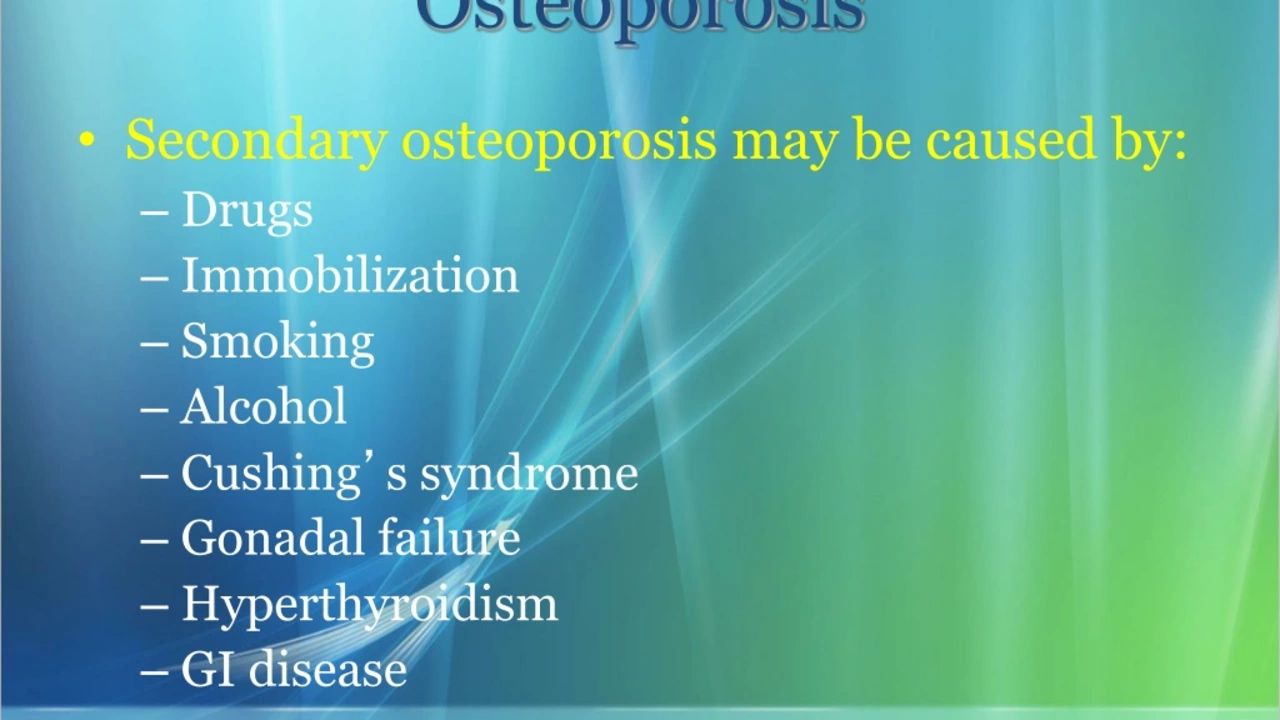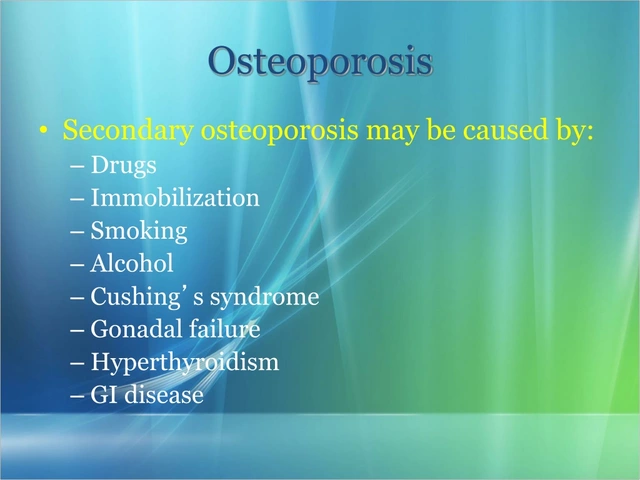The Impact of Smoking and Alcohol on Osteoporosis Risk
Understanding Osteoporosis: A Silent Bone Disease
Osteoporosis, often referred to as the silent disease, is a condition that weakens the bones, making them fragile and more prone to fractures. It's known as a silent disease because it can progress undetected for many years without symptoms until a fracture occurs. Osteoporosis affects millions of people around the world, particularly post-menopausal women, but men can also be affected. A major concern with osteoporosis is that it significantly increases the risk of fractures, which can lead to serious health complications and decreased quality of life.
Smoking and Its Detrimental Effects on Bone Health
Smoking has long been known to be harmful to our health, but its impact on bone health is not often highlighted. As a smoker, your body's ability to absorb calcium, an essential nutrient for bone health, is severely compromised. This can lead to decreased bone density, making your bones weaker and more prone to fractures. Furthermore, smoking reduces blood supply to the bones, slows the production of bone-forming cells, and impairs the body's balance of hormones that protect the bones. These factors all contribute to increased osteoporosis risk.
Alcohol: A Hidden Risk Factor for Osteoporosis
Like smoking, excessive alcohol consumption can also have detrimental effects on bone health. Alcohol interferes with the body's ability to absorb and utilize calcium. Moreover, it can disrupt the production of hormones that are necessary for bone health, such as estrogen and testosterone. Chronic heavy drinking, especially during the teenage and young adult years when bone mass is being built, can dramatically affect bone health and increase the risk of osteoporosis. Even moderate alcohol consumption can be harmful if it is frequent and over a long period of time.
Prevention and Management of Osteoporosis: Lifestyle Changes
Prevention is always better than cure. Lifestyle changes can significantly reduce the risk of osteoporosis. If you smoke, quitting is the best thing you can do for your bone health. Similarly, if you drink alcohol, it's important to do so in moderation. Regular weight-bearing and muscle-strengthening exercises are also beneficial for bone health. A balanced diet rich in calcium and vitamin D is crucial. Exposure to sunlight, which helps our bodies produce vitamin D naturally, is also beneficial.
Medical Treatments and Interventions for Osteoporosis
If you have been diagnosed with osteoporosis or are at high risk, there are a variety of medical treatments and interventions available to help manage the condition. Medications, such as bisphosphonates, can help slow bone loss. Hormone replacement therapy (HRT) can be beneficial, especially for post-menopausal women. In severe cases, surgical options, such as vertebroplasty or kyphoplasty, may be considered. However, it's important to note that while these treatments can help manage osteoporosis, they cannot cure the disease. Therefore, prevention and early detection remain the best strategies for dealing with osteoporosis.










Smoking? Alcohol? Bro, I thought we were talking about bone health, not a bad Tinder date. You smoke, you drink, you break a hip at 45, and then you blame the bones. Newsflash: your body’s not a magic box that ignores your chaos.
i read this and thought of my grandpa in india who smoked 20 cigarettes a day since 1960 and still walks 5km every morning. he says his bones feel stronger than his grandson’s wifi. maybe it’s not just the smoke? maybe it’s the chai?
So let me get this straight. You’re telling me the same people who think kale is a ‘superfood’ and yoga fixes everything are now surprised that smoking and drinking wreck bones? Honey, your bone density is not a TikTok trend you can filter out.
Let’s be real: osteoporosis isn’t ‘silent’-it’s just ignored by a culture that treats the body like a disposable app. You swipe right on beer, swipe left on calcium, and then wonder why your spine looks like a collapsed Jenga tower. The science is clear. The denial? Not so much.
I appreciate this breakdown. My mom was diagnosed last year. She quit smoking, cut back on wine, and started walking daily. Her BMD improved by 3% in 10 months. Small changes matter.
It’s not just about calcium and vitamin D, you know? It’s the quiet grief of watching your body betray you after decades of ignoring it. The way your bones creak in the morning like old floorboards. The fear of a sneeze turning into a fracture. We don’t talk about this enough. We talk about ‘lifestyle’ like it’s a spa day, not a life sentence.
Convenient how the medical-industrial complex blames smoking and alcohol while ignoring that bisphosphonates cause jaw necrosis and HRT increases cancer risk. They don’t want you to know that the real culprit is corporate sugar and vitamin D deficiency from living indoors. The truth is buried under profit-driven pamphlets.
My uncle in Delhi smoked like a chimney and drank whiskey like water. Broke his hip at 72. Still alive. Still drinking. Still smoking. Guess the science ain’t universal.
In India we say ‘dhoop aur dawa’-sunlight and medicine. My dad never quit smoking but he drank turmeric milk every morning and sat in the sun till his shirt stuck to his back. He’s 81. No fractures. Maybe the real enemy isn’t the smoke… it’s the air conditioning?
I’m 32. I’ve never smoked. I drink maybe twice a month. I lift weights. I take vitamin D. And I still got osteopenia. So… what’s the real story? Is it genetics? Stress? The fact that I work in a basement with zero windows?
This article is just fearmongering with footnotes. Everyone knows alcohol and smoking are bad. But you’re gonna tell a 60-year-old who’s been drinking since 1975 to stop? Nah. He’s gonna keep drinking, and you’re gonna keep writing articles. We’re all just waiting for the next miracle cure.
I’m not saying smoking and drinking don’t hurt bones, but you ever think maybe the real problem is that we’re all just too damn sedentary? I’ve seen 80-year-olds in Japan who drink sake daily and still squat their grandkids. Maybe it’s not the booze… it’s the lack of squatting.
The correlation between smoking, alcohol, and osteoporosis is statistically robust and biologically plausible. However, the oversimplification of causality in public health messaging often neglects the role of epigenetic variation, socioeconomic determinants of health, and the differential impact of cultural dietary practices. One cannot universally prescribe lifestyle modifications without acknowledging systemic inequities in access to nutrition, healthcare, and safe environments for physical activity. Therefore, while personal responsibility is a component, structural intervention remains non-negotiable.
You got this. 💪 Even if you’ve smoked for 30 years, quitting now still helps. Your bones are still listening. Start with a walk. Add a glass of milk. One day at a time. You’re not too late.